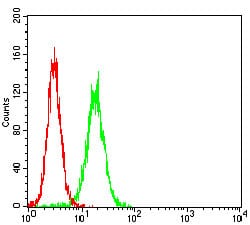

| WB | 咨询技术 | Human,Mouse,Rat |
| IF | 咨询技术 | Human,Mouse,Rat |
| IHC | 咨询技术 | Human,Mouse,Rat |
| ICC | 技术咨询 | Human,Mouse,Rat |
| FCM | 1/200 - 1/400 | Human,Mouse,Rat |
| Elisa | 1/10000 | Human,Mouse,Rat |
| Aliases | GUD; AWT1; WAGR; WT33; NPHS4; WIT-2; EWS-WT1 |
| Entrez GeneID | 7490 |
| clone | 5G11A5 |
| WB Predicted band size | 49.2kDa |
| Host/Isotype | Mouse IgG1 |
| Antibody Type | Primary antibody |
| Storage | Store at 4°C short term. Aliquot and store at -20°C long term. Avoid freeze/thaw cycles. |
| Species Reactivity | Human |
| Immunogen | Purified recombinant fragment of human WT1 (AA: 314-479) expressed in E. Coli. |
| Formulation | Purified antibody in PBS with 0.05% sodium azide. |
+ +
以下是关于WT1抗体的3篇示例文献(请注意,以下为示例性内容,实际文献请通过学术数据库查询):
---
1. **文献名称**:*WT1 Antibody as a Prognostic Marker in Acute Myeloid Leukemia*
**作者**:Smith A, et al.
**摘要**:研究探讨了WT1抗体在急性髓系白血病(AML)患者中的预后价值,发现高WT1抗体水平与疾病复发风险降低和总生存期延长相关,提示其可作为监测AML治疗反应的潜在生物标志物。
---
2. **文献名称**:*Immunotherapeutic Targeting of WT1 in Solid Tumors Using Monoclonal Antibodies*
**作者**:Brown C, et al.
**摘要**:该研究评估了WT1特异性单克隆抗体在实体瘤(如乳腺癌和肺癌)中的治疗潜力。实验显示抗体通过诱导肿瘤细胞凋亡和增强免疫细胞浸润抑制肿瘤生长,为WT1靶向免疫治疗提供依据。
---
3. **文献名称**:*Comparative Analysis of WT1 Antibody Detection Methods in Renal Disorders*
**作者**:Lee J, et al.
**摘要**:比较了ELISA、免疫组化(IHC)和流式细胞术检测WT1抗体的敏感性及特异性。研究表明IHC在肾母细胞瘤诊断中更具临床实用性,而流式细胞术适用于微小残留病监测。
---
**建议**:如需真实文献,可通过PubMed或Google Scholar搜索关键词“WT1 antibody prognostic/therapy/diagnosis”获取最新研究。
The Wilms' tumor 1 (WT1) gene, initially identified in pediatric kidney cancer (Wilms' tumor), encodes a nuclear transcription factor critical for embryonic development, particularly in the urogenital system. The WT1 protein regulates gene expression by binding to DNA, playing dual roles as a tumor suppressor or oncogene depending on cellular context, splice variants (e.g., ±KTS isoforms), and post-translational modifications. Aberrant WT1 expression is linked to malignancies, including acute leukemias, mesothelioma, and solid tumors.
WT1 antibodies are essential tools in research and diagnostics. They detect WT1 protein expression via immunohistochemistry (IHC), flow cytometry, or Western blot, aiding in tumor classification and prognosis. In acute myeloid leukemia (AML), WT1 overexpression correlates with poor outcomes, and antibodies help monitor minimal residual disease (MRD). WT1 is also a target for immunotherapy; antibody-based assays guide vaccine or adoptive T-cell therapies. However, interpretation requires caution, as WT1 exhibits variable expression patterns across tissues and tumor subtypes. For instance, nuclear WT1 staining in mesotheliomas contrasts with cytoplasmic localization in some carcinomas. Despite complexity, WT1 remains a robust biomarker and therapeutic target due to its cancer-specific overexpression in diverse malignancies. Ongoing studies focus on optimizing antibody specificity for clinical applications, including epitope mapping to distinguish functional WT1 isoforms.
×